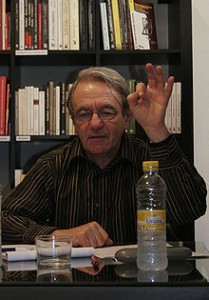
Arquivo para January 7th, 2015
Ranciére: image and technology
 Jacques Rancière argues that the image already met its fate (The Future of the Image, 2007) and it is not fetishism, for it continued their power directly affect man and at the same time are record and marks in history to educate and transform .
Jacques Rancière argues that the image already met its fate (The Future of the Image, 2007) and it is not fetishism, for it continued their power directly affect man and at the same time are record and marks in history to educate and transform .
But it is important and possible to put them in a relationship to be, if we remember the category difference and repetition (Heidegger, Deleuze and others), the temporal image operations and the time-image, I prefer the category dynamic image, it can be think that this belongs to the future emanating from it.
It is no longer the painter of the frame or photo, although they persist and continue to have an ontological importance of recording, but now one can speak in combinations and breaks the visible and speakable ad infinitum, as Rancière thinks.
What Rancière says in the background, of course is just a vision of an interpreter, is that politics is not just a struggle for power, but should always have a certain distribution of the sensible, a redefinition of ways to view and organize the real, and this are also the networks and the virtual.
This particular form of the sensitive agency that gives visibility to things in a way that previously they had not, and opens the person who appropriates the new ferrramentas in good ways to work on the power to speak and act in social alliances, not just party or sectorized groups.
In reading Ranciére notes the concern with the possibility of aesthetic acts were likely always new ways of feeling common to new forms of political subjectivity (Rancière,2009).
Jacques Rancière: Politics, History, Aesthetics (2000). Eds. Phil Watts and Gabriel Rockhill. (Durham & London: Duke University Press, 2009), and I think that technologies enable and empower this possibility.

